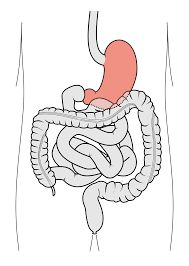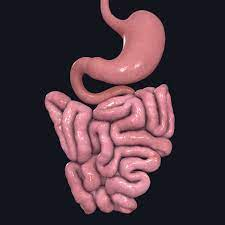The Stomach
- Leandra Cardenas

- Nov 30, 2022
- 5 min read
The stomach is a vital organ that is necessary for digestion and is located in the upper left quadrant and without it we would be unable to eat correctly. Digestion starts in the mouth where teeth tear food into smaller pieces and saliva moistens it so it can move down the esophagus and into the stomach. The stomach stores food until it can be digested, which begins with pepsin, an enzyme, breaking down proteins. After this process, the stomach continues to break down food with its acid and enzymes, which are needed to break down carbohydrates.

Located in the abdominal cavity, the stomach is an organ that serves as a food storage and digestive organ. It consists of five major parts: cardia, fundus, body, antrum, and pylorus. The fundus is located at the top of the stomach and attaches to the esophagus; it's where food enters from the esophagus. The body is found between the fundus and antrum; this part contains glands that secrete hydrochloric acid to help break down food particles for digestion. The antrum is located at the base of the stomach, separated by a valve called pylorus from where acidic chyme enters after being digested through enzymes in the small intestines. Finally, the pylorus opens into the duodenum of the small intestine, where bile salts are added for fat digestion and water is removed so that only a thick substance remains which passes on to the large intestine.
The stomach is a muscular organ located in the upper left quadrant and extending to the diaphragm. It's part of the gastrointestinal tract, which starts at the mouth and ends at the anus. The size of your stomach varies depending on your age, sex, weight, diet, and other factors - adults have an average size around 3 cups but some people have as much as 5 liters. The stomach has three layers: an outer layer called a serosa; a middle layer called a muscularis; and an inner layer called a mucosa. The stomach is lined with a thin layer of mucous membrane, which is covered by a layer of epithelium that consists primarily of simple columnar cells. This is known as the gastric mucosa and it helps protect the lining from any outside bacteria or food particles that could harm it. The epithelium also contains cells called goblet cells that produce a substance called mucus, which coats any food particles or bacteria that may have made their way into the stomach. The mucus layer can trap these particles so they cannot irritate and damage the delicate tissue below them while they are being digested. There are two types of glands found in the stomach: parietal glands and chief cells. The parietal glands secrete a fluid that covers up any food particles or bacteria on top of the mucous membrane before they come into contact with other tissues. Chief cells provide more protection for the stomach lining by secreting substances all necessary for digestion to take place properly. The stomach is lined with gastric pits. Underneath these are glands that secrete gastric juice which contains hydrochloric acid, potassium chloride, sodium chloride, and proteins like pepsinogen. Hormones such as gastrin stimulate more production of gastric juices when needed. The cells that make up the gastric mucosa are called gastric chief cells or oxyntic cells, and they are responsible for secreting hydrochloric acid into the stomach. Other types of tissue found in the stomach include cardiac muscle tissue and cardiac glands, which secrete a protective mucus layer that coats the stomach lining to protect it from digestive enzymes; pyloric muscle tissue for peristalsis; and fundus muscle tissue for peristalsis as well. Furthermore, there is a lamina propria made up of connective tissue that is layered between two muscular layers (tunica muscularis). In this layer there are two layers: one composed primarily of macrophages while another is mainly plasma cells. These specialized immune cells attack any bacteria that has leaked out of food through cracks in the stomach wall.
The digestive system is made up of a series of organs that work together to break down food into nutrients, which can then be absorbed into the body. The stomach is considered as being part of this system because it produces hydrochloric acid and gastric lipase, which are necessary for breaking down food. The food then moves through the esophagus and enters the stomach, where it is mixed with hydrochloric acid and digestive enzymes that further break down food particles. The partially digested mixture passes from the stomach into a long tube called the small intestine, where most absorption occurs as nutrients are pulled through its walls by tiny finger-like projections called villi. The nutrients are then absorbed by the blood stream. Bile salts help break down fats while proenzymes like proteases break down protein into amino acids before they are absorbed by the bloodstream. In order to absorb certain vitamins, specific molecules must first bind to specific receptors found in the lining of the stomach. However, many minerals cannot be absorbed without an active form, so we need to eat them bound with a mineral carrier, not just taking them orally. After they are passed on to other tissues and organs, including the liver, kidneys, gallbladder, pancreas, ovaries or testes. With the nutrients many things are possible, the liver produces bile and stores vitamin A, the kidneys produce urine, the gallbladder stores bile, the pancreas secretes insulin; And the ovaries or testes produce eggs or sperm.
Stomach disorders can affect the way you digest food and nutrients, which can have a significant impact on your health and wellness. Acid reflux occurs when stomach acids reflux up the esophagus, commonly known as gastroesophageal reflux disease. Peptic ulcers, often known as stomach ulcers, are acid-induced sores in the intestinal lining. Acid reflux and stomach ulcers are common issues that can cause pain, nausea, vomiting, weight loss, and other unpleasant symptoms. Cyclic vomiting syndrome is a condition in which you vomit nonstop and it can continue for days. In order to prevent people from
vomiting non-stop when people vomit, the lower end of their esophagus tightens while they swallow another mouthful of food or drink before the person can vomit again. The condition can lead to severe dehydration and possibly damage to your thyroid. Lactose intolerance is a disorder in which the body is unable to digest lactose due to a deficiency of lactase, a digestive enzyme. The condition can cause diarrhea, gasses, and bloating in a person who is lactose intolerant.
The stomach has two important functions in the human body, and both are vital to the way we live our everyday lives. The first function of the stomach is that it acts as a storage space for food until you’re ready to digest it and extract energy from it. The second function of the stomach is that it acts as an acid bath in which food can be broken down before being sent into the small intestine, where nutrients are absorbed.




Comments